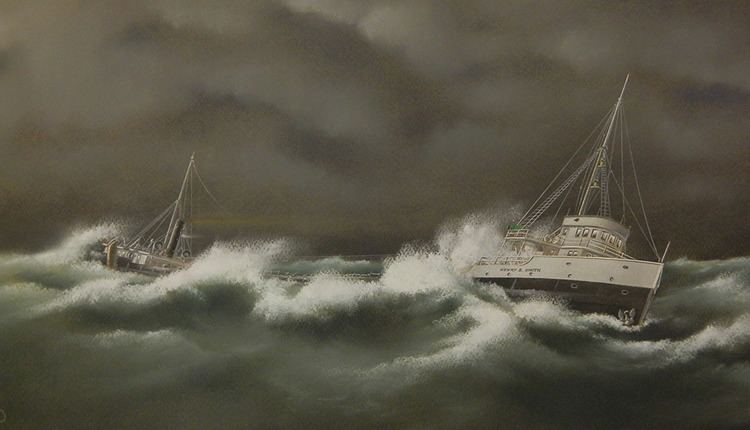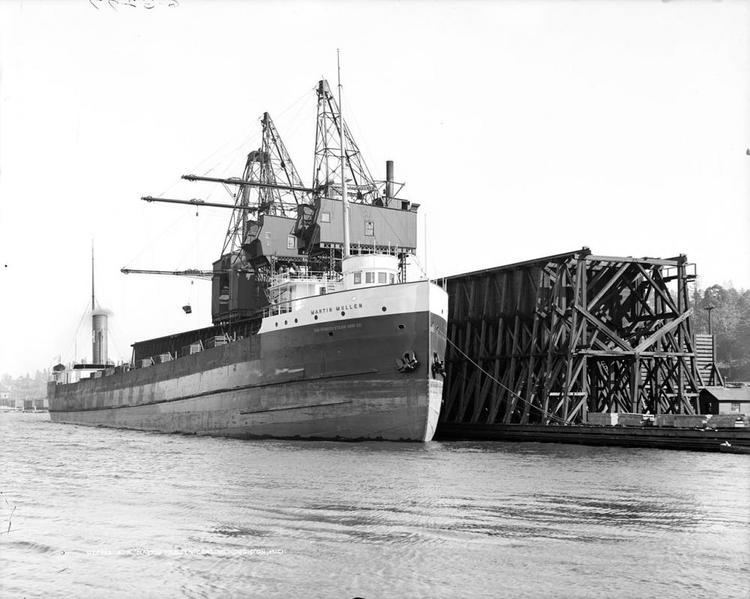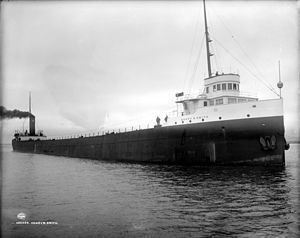Name Henry B. Smith Completed May 20, 1906 Length 160 m | Yard number 343 Launched 2 May 1906 | |
 | ||
Operator Acme Transit Company
(William A. Hawgood, Mgr.)
Cleveland, Ohio Fate Foundered and sunk November 10, 1913 Notes United States Registry #203143 Builder American Ship Building Company | ||
The SS Henry B. Smith was a steel-hulled, propeller-driven lake freighter built in 1906 by the American Ship Building Company at Lorain, Ohio USA. The steamship was owned by the Acme Transit Company of Lorain, Ohio, under the management of William A. Hawgood. The hull number was 343 and the registration number was US203143.
Contents

The Henry B. Smith was 525 feet in length, 55 feet in width, and 31 feet in height. The gross tonnage for the vessel was 6,631, and the net tonnage was 5,229. The engine was a triple-expansion type. She was named for Henry B. Smith (1849-1918), a prominent lumberman who was managing owner of the Ludington Woodenware Company in Ludington, Michigan.

The ship foundered and was lost in Lake Superior near Marquette, Michigan, on 9 or 10 November 1913 during the Great Lakes Storm of 1913. She was carrying a load of iron ore at the time of her sinking. All 25 crew members died in the sinking, and only two bodies were retrieved from the lake.

The wreck was discovered in 2013, one hundred years after she disappeared.
Last voyage

The Smith arrived at Marquette on November 6 to take on iron ore. Over the next two days a southwest gale swept over Lake Superior, dropping the temperature to 24 degrees Fahrenheit. The cold weather caused the ore to freeze inside the hopper cars, requiring men to knock them loose by hand. This resulted in a loading delay for the Smith. Captain James Owen had been plagued by misfortunes all year that had resulted in the Smith being delayed or late for its destinations. Rumors abounded, then and now, that the owners of the boat made it clear to Owen that he better make this last trip on time, or else.
Around 5 p.m. on November 9, the Smith loaded its last car of ore. Since the gale seemed to be in a brief lull, the big freighter immediately backed away from the dock and began to leave. As soon as the Smith left Marquette Harbor, the fierce wind returned and the storm's lull ended. Witnesses on shore noted that the deckhands were frantically trying to close the Smith's hatches. The freighter had a total of 32 hatches; each hatch required individual attention with locking bars, clamps, and tackle. It was a couple hours' work for even the most skilled crew. And so it was that Captain James Owen was piloting the Henry B. Smith into one of the worst storms in memory with unsecured hatches.
After about twenty minutes, the full force of the gale hit the Smith as huge waves crashed over her deck, drenching the hapless deckhands who were still struggling to close the hatches. Instead of turning to starboard on the usual course for the Soo Locks, the Smith hauled to port, rolling greatly as she did so. Witnesses on shore concluded that Owen had realized his error and was heading for shelter behind Keweenaw Point to the north. With the encroaching darkness and thick snow squalls, the Smith was then lost from view.
Two days after the storm blew itself out, the beaches along Chocolay Bay, Shot Point, and Laughing Fish Point were littered with debris from the Smith. The wreckage was found high up on the beach, indicating it came ashore at the height of the storm. The body of the second cook, H.R. Haskin, was found floating about fifty miles west of Whitefish Point some days later. Only one other body of the Smith's crew was ever recovered; the skeleton of third engineer John Gallagher was found on Parisian Island in the spring of 1914.
A note in a bottle, allegedly from the Smith, was found in June 1914. In it, the author claimed the ship had broken in two 12 miles east of Marquette. After a long debate, the boat's owners decided the note was a phony; it was dated 12 November, when the Smith sank either on the 9th or the early morning hours of the 10th.
Wreck located in 2013
The wreck was located in May 2013 by shipwreck hunters. The ship lies in 535 feet (163 m) of water off of Marquette. Video the following month confirmed this wreck to be the Henry B. Smith.
